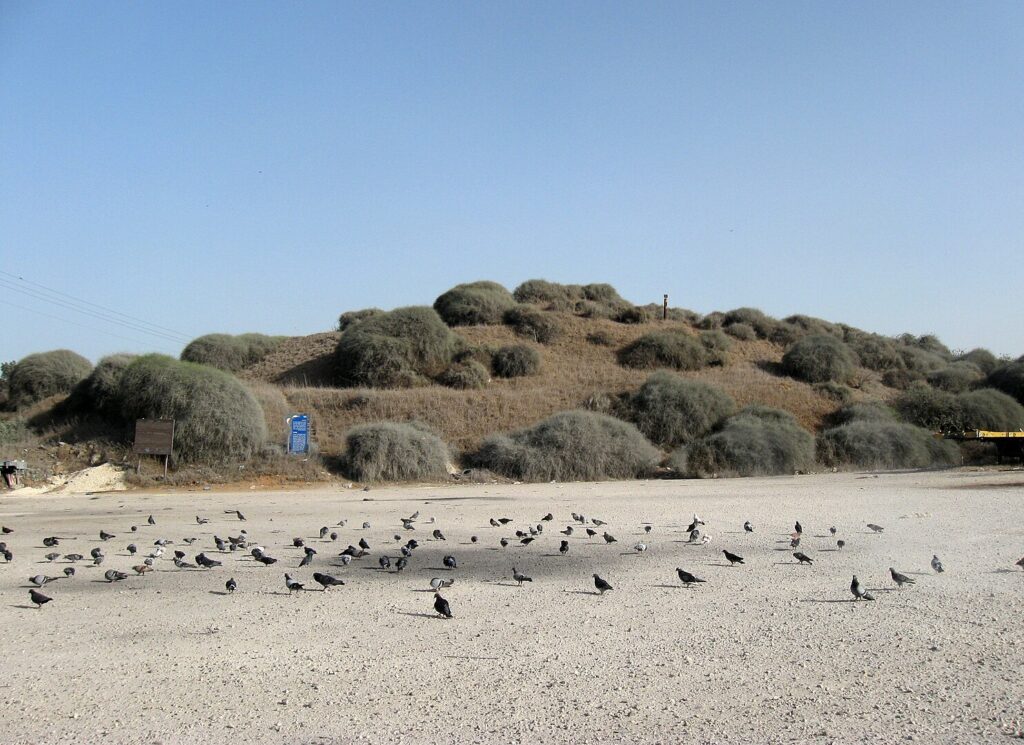Tel Mor is a small mound that sits on the north bank of Nahal Lakish at a distance of one kilometer from the Mediterranean Sea, east of the port of Ashdod. The area of the mound at its base is about six dunams and at its top about a dunam. The mound sits on a small kurkar hill among the dunes of the southern coastal plain and is 17 meters above its base and 25 meters above sea level. Tel Mor was apparently used as an anchorage during the Bronze and Iron Ages, perhaps in the service of the city of Ashdod – the largest of the cities in the region of Tel Mor and a city about six kilometers from the sea. Historical evidence shows that the Lachish stream was deeper in the past than nowadays and allowed the passage of boats and small ships, this is a significant element in an area of a coast without bays that makes it difficult for ships to anchor safely. Tel Mor was excavated in 1959-1960 by a team led by Moshe Dotan.

Identification with ancient places
Tel Mor is a transliteration of one of the names of the hill in Arabic – Tel al-Mora. The ancient name of the place is not clear, but it has been proposed to identify it with a place called Mehaz mentioned in the Al-Amarna letters (mid-14th century BC) and in a list of places from the time of Ramses II (1213-1279 BC), where Mehaz is mentioned as a place located between Sarrohan and Shuka which corresponds to the place of Tel Mor.
The Bronze Age
The beginning of the settlement at Tel Mor is towards the end of the Middle Bronze Age (the first half of the 16th century BC), from this period few finds were uncovered in Tel and it is difficult to testify to the nature of the site at this stage. The Late Bronze Age at Tel Mor (1550-1150 BC) approx.) is much clearer. From its early phase (1550-1450 BC) a small ritual area was discovered that was identified by Moshe Dotan as a stage. From the 14th century BC, still in the Late Bronze Age, buildings and graves were uncovered with a material culture of a distinctly local character and signs of the settlement’s destruction at the beginning 13th century BC. It is possible that the settlement was destroyed by Seti I in his war campaign to Canaan in 1290 or 1294 BC. On top of the ruins, still in the Late Bronze Age, a new settlement of Egyptian character was established. A large building in Egyptian architectural style was built on top of the mound and beer jugs and Egyptian style bowls were found throughout the mound that were used by the people who ruled the site. Tel Mor during this period was apparently used as a small Egyptian base in Canaan. This building was destroyed towards the end of the Bronze Age, possibly as a result of Canaanite rebellions. After that, a new large building was built on top of the previous building, also of Egyptian character, which was also destroyed at the end of the Bronze Age or the beginning of the Iron Age at the end of the 13th century or the beginning of the 12th century BC. The destruction of the last Egyptian building was also The end of Egyptian rule in Tel Mor as part of the end of Egyptian rule in Canaan.
The iron age
During the Iron Age, after the end of Egyptian rule, the character of the settlement at Tel Mor changed. Instead of a large building that was used as a military base, the site became a small settlement with almost no buildings. This settlement was destroyed in the tenth century BC and on top of it few remains were found from later phases in the Iron Age. It is possible that the settlement of Tel Mor during the Iron Age is connected to the rise of Ashdod Yam at the same time, which became the port of the city of Ashdod instead of Tel Mor.
The Hellenistic Period
Tel Mor was abandoned for hundreds of years until the Hellenistic period. During this period, in the 2nd century BCE, a complex for the production of crimson was established in the lower part of the hill. The complex included facilities that were used for the dye production process and thousands of crimson shells were discovered in a nearby well. Moshe Dotan suggested that the crimson production complex was destroyed and looted by Judah the Maccabee according to the story In the book of the Hasmoneans, Judah chased the Seleucid army as far as Ashdod and returned with loot that included scarlet.
Late periods
Tel Mor is no longer occupied, but in the Roman period a well was dug there and in the Ottoman period there was a cemetery there. In World War I, Ottoman forces fortified Tel Mor in 1917 but were defeated by Australian soldiers in the service of Britain. The British then used the Lachish River as an anchorage to land supplies from the sea.
sources
Moshe Dotan. 1957. “The Excavations at Tel-Mor in the Season of 1959” Bulletin of the Society for the Investigation of Israel and its Antiquities, 1957 24:2\3, 120-132.
Tel Mor on the Israel Archaeological Survey website. Map of Ashdod (84), site 18. Published in 2011.
Tristan J. Barako and Donald T. Ariel. 2007. Tel Mor: The Moshe Dothan Excavations 1959-1960. Jerusalem.


